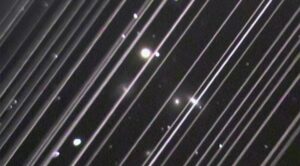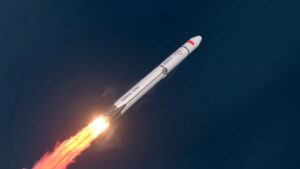Astroscale and rocket maker MHI team up to develop debris removal technology
Tuesday, 27 July 2021 15:16
WASHINGTON — Astroscale, an orbital debris removal and satellite servicing company based in Japan, announced July 27 that it will be working with rocket maker Mitsubishi Heavy Industries on technologies to help clean up space junk.
Galileo Project to search for ET artifacts in galactic space
Tuesday, 27 July 2021 11:16 The multi-institutional, international Galileo Project founders, research team and advisory boards, in conjunction with the Center for Astrophysics | Harvard and Smithsonian, today announce the Galileo Project .
It is a transparent scientific project to advance a systematic experimental search for cross-validated evidence of potential astroarcheological artifacts or active technical equipm
The multi-institutional, international Galileo Project founders, research team and advisory boards, in conjunction with the Center for Astrophysics | Harvard and Smithsonian, today announce the Galileo Project .
It is a transparent scientific project to advance a systematic experimental search for cross-validated evidence of potential astroarcheological artifacts or active technical equipm NASA's role in agriculture
Tuesday, 27 July 2021 11:16 Everybody needs to eat. Food is a basic necessity, and it is at the heart of every human culture and our sense of home. It also represents one of our most important connections to Earth. Crops and animal products, whether gathered from the ocean or the land, raised on farms big and small, across vast fields or in our backyards and urban communities, draw on sunlight, water and soil to grow and t
Everybody needs to eat. Food is a basic necessity, and it is at the heart of every human culture and our sense of home. It also represents one of our most important connections to Earth. Crops and animal products, whether gathered from the ocean or the land, raised on farms big and small, across vast fields or in our backyards and urban communities, draw on sunlight, water and soil to grow and t What you need to know about Starliner's Test-2
Tuesday, 27 July 2021 11:16 NASA and Boeing are taking another major step on the path to regular human spaceflight launches to the International Space Station on American rockets and spacecraft from American soil with the second uncrewed flight test of Boeing's CST-100 Starliner as part of the agency's Commercial Crew Program.
NASA's Boeing Orbital Flight Test-2 (OFT-2) is targeting launch of the Starliner spacecraft
NASA and Boeing are taking another major step on the path to regular human spaceflight launches to the International Space Station on American rockets and spacecraft from American soil with the second uncrewed flight test of Boeing's CST-100 Starliner as part of the agency's Commercial Crew Program.
NASA's Boeing Orbital Flight Test-2 (OFT-2) is targeting launch of the Starliner spacecraft Space food costs are out of this world
Tuesday, 27 July 2021 11:16 Space exploitation/exploration is expensive. For example, the transportation cost for each lemon sent to the International Space Station (ISS) may cost over $2,000. Such lemons and other food supplies are sent to the station periodically by cargo modules from U.S. and Russian suppliers.
Since the retirement of the Space Shuttle in 2011, NASA has been using other sources for resupplying the
Space exploitation/exploration is expensive. For example, the transportation cost for each lemon sent to the International Space Station (ISS) may cost over $2,000. Such lemons and other food supplies are sent to the station periodically by cargo modules from U.S. and Russian suppliers.
Since the retirement of the Space Shuttle in 2011, NASA has been using other sources for resupplying the Zhurong marks 1st anniversary since launch with dune exploration
Tuesday, 27 July 2021 11:16 China's Zhurong Mars rover finished exploring a sand dune on the red planet on the first anniversary of the launch of the country's first interplanetary expedition, the China National Space Administration said on Friday.
The robot headed toward the dune earlier this week and began to take photographs, then activated onboard scientific equipment to survey the dune and its surroundings, the
China's Zhurong Mars rover finished exploring a sand dune on the red planet on the first anniversary of the launch of the country's first interplanetary expedition, the China National Space Administration said on Friday.
The robot headed toward the dune earlier this week and began to take photographs, then activated onboard scientific equipment to survey the dune and its surroundings, the How Chinese astronauts stay healthy in space
Tuesday, 27 July 2021 11:16 Three Chinese astronauts have been living and working in China's space station core module Tianhe for more than a month. They are scheduled to stay in space for three months.
The astronauts have been exercising, maintaining healthy diets and undergoing regular check-ups to reduce the effects of living in a microgravity environment.
Scientists have found that microgravity weakens both
Three Chinese astronauts have been living and working in China's space station core module Tianhe for more than a month. They are scheduled to stay in space for three months.
The astronauts have been exercising, maintaining healthy diets and undergoing regular check-ups to reduce the effects of living in a microgravity environment.
Scientists have found that microgravity weakens both D-Orbit completes deployment phase of WILD RIDE space mission
Tuesday, 27 July 2021 11:16 D-Orbit, the space logistics and transportation company, announced that it has successfully completed the deployment phase of its WILD RIDE mission. As part of this phase, D-Orbit's ION Satellite Carrier (ION), the company's proprietary space transportation vehicle, successfully deployed all six satellites hosted onboard and will now proceed with the in-orbit demonstration of 12 hosted payloads.
D-Orbit, the space logistics and transportation company, announced that it has successfully completed the deployment phase of its WILD RIDE mission. As part of this phase, D-Orbit's ION Satellite Carrier (ION), the company's proprietary space transportation vehicle, successfully deployed all six satellites hosted onboard and will now proceed with the in-orbit demonstration of 12 hosted payloads. MDA awarded next contract for flagship Canadarm3 Program
Tuesday, 27 July 2021 11:16 MDA Ltd. has been awarded a $35.3 million contract from the Canadian Space Agency (CSA) for the design of the Gateway External Robotics Interfaces (GERI), a key component of Canadarm3 which will be installed on the international Lunar Gateway.
MDA has completed Phase A, the system definition phase of this GERI project. This new contract award covers the preliminary and detailed design of t
MDA Ltd. has been awarded a $35.3 million contract from the Canadian Space Agency (CSA) for the design of the Gateway External Robotics Interfaces (GERI), a key component of Canadarm3 which will be installed on the international Lunar Gateway.
MDA has completed Phase A, the system definition phase of this GERI project. This new contract award covers the preliminary and detailed design of t Progress 77 and Pirs undocked from Station
Tuesday, 27 July 2021 11:16 The unpiloted Russian Progress 77 cargo spacecraft undocked from the International Space Station while attached to the Pirs docking compartment at 6:55 a.m. EDT.
The spacecraft will reenter Earth's atmosphere and harmlessly burn up over the south Pacific. The mission launched and docked to the space station in February delivering more than a ton of cargo to the Expedition 65 crew.
De
The unpiloted Russian Progress 77 cargo spacecraft undocked from the International Space Station while attached to the Pirs docking compartment at 6:55 a.m. EDT.
The spacecraft will reenter Earth's atmosphere and harmlessly burn up over the south Pacific. The mission launched and docked to the space station in February delivering more than a ton of cargo to the Expedition 65 crew.
De NASA's Fermi Spots a Supernova's 'Fizzled' Gamma-ray Burst
Tuesday, 27 July 2021 11:16 Greenbelt MD (SPX) Jul 27, 2021
On Aug. 26, 2020, NASA's Fermi Gamma-ray Space Telescope detected a pulse of high-energy radiation that had been racing toward Earth for nearly half the present age of the universe. Lasting only about a second, it turned out to be one for the record books - the shortest gamma-ray burst (GRB) caused by the death of a massive star ever seen.
GRBs are the most
Greenbelt MD (SPX) Jul 27, 2021
On Aug. 26, 2020, NASA's Fermi Gamma-ray Space Telescope detected a pulse of high-energy radiation that had been racing toward Earth for nearly half the present age of the universe. Lasting only about a second, it turned out to be one for the record books - the shortest gamma-ray burst (GRB) caused by the death of a massive star ever seen.
GRBs are the most Apollo to Artemis: Drilling on the Moon
Tuesday, 27 July 2021 11:16 Fifty years ago, Apollo 15 lifted off from Kennedy Space Center, sending Commander David R. Scott, Command Module Pilot Alfred M. Worden, and Lunar Module Pilot James B. Irwin on the first of three Apollo "J" missions.
These missions gave astronauts the opportunity to explore the Moon for longer periods using upgraded and more plentiful scientific instruments than ever before. Apollo 15 wa
Fifty years ago, Apollo 15 lifted off from Kennedy Space Center, sending Commander David R. Scott, Command Module Pilot Alfred M. Worden, and Lunar Module Pilot James B. Irwin on the first of three Apollo "J" missions.
These missions gave astronauts the opportunity to explore the Moon for longer periods using upgraded and more plentiful scientific instruments than ever before. Apollo 15 wa Hubble finds first evidence of water vapor on Ganymede
Tuesday, 27 July 2021 11:16 For the first time, astronomers have uncovered evidence of water vapor in the atmosphere of Jupiter's moon Ganymede. This water vapor forms when ice from the moon's surface sublimates - that is, turns from solid to gas.
Scientists used new and archival datasets from NASA's Hubble Space Telescope to make the discovery, published in the journal Nature Astronomy.
Previous research has offere
For the first time, astronomers have uncovered evidence of water vapor in the atmosphere of Jupiter's moon Ganymede. This water vapor forms when ice from the moon's surface sublimates - that is, turns from solid to gas.
Scientists used new and archival datasets from NASA's Hubble Space Telescope to make the discovery, published in the journal Nature Astronomy.
Previous research has offere Astronomers back technical efforts to reduce impacts of satellite megaconstellations while seeking regulatory solutions
Tuesday, 27 July 2021 10:31
WASHINGTON — With slow progress on regulation and policy, astronomers are making progress on other approaches to mitigate the effects that satellite megaconstellations will have on their observations.
At the conclusion of the weeklong SATCON2 workshop July 16, astronomers announced a proposal to develop a virtual center called SatHub that will provide tools for astronomers to avoid satellite passes in their observations or correct observations affected by such passes.
Chinese rocket company Space Pioneer secures major funding ahead of first launch
Tuesday, 27 July 2021 08:16
HELSINKI — Chinese commercial rocket company Space Pioneer has secured a large funding round ahead of reusable “hop” tests and a first orbital launch.
